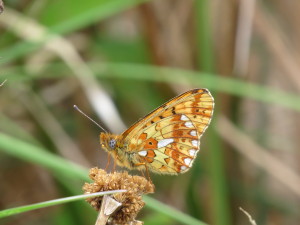Woodland Pearl makes a comeback at Grafton Wood.
A rare butterfly, released into a patch of Worcestershire woodland after a 30-year absence, has been seen in record numbers this spring – just three years after its re-introduction.
The Pearl-bordered Fritillary used to be a common sight in the West Midlands between mid-April and July. The butterfly is identified by a distinctive orange and yellow hindwing with a border of silver ‘pearls’. Since the 1950s its numbers have declined to such a point that it’s now recognised as one of the country’s most endangered butterflies.
In 2011, Butterfly Conservation’s West Midlands Branch released 24 adult Pearl-bordered Fritillary’s into Grafton Wood – a reserve the charity jointly owns with the Worcestershire Wildlife Trust.
During the following year – the worst on record for butterflies and one of our wettest ever summers – only one butterfly was recorded at the site. This year, up to 12 have been seen in just one day, with sightings of more than 50 coming in each week.
John Tilt, reserve manager, said: “Before the release we spent five years creating a suitable habitat at Grafton, but after the awful year of 2012 we were worried it had all been for nothing.
“The numbers being seen this year are quite simply incredible and it finally feels like all our hard work is paying off. Their activity is focussed on one small part of the reserve where we removed a lot of the conifer trees and left the ground to re-establish itself. The females are there now and I’ve got my fingers crossed they’re breeding.”
The butterfly is also doing well in the Wyre Forest, where strict woodland management allows for flowers like violets to grow in great numbers. The Pearl-bordered Fritillary lays its eggs on violets, which are the main food plant of its caterpillar.
Butterfly Conservation Chief Executive Dr Martin Warren said: “It is wonderful news that the Pearl-bordered Fritillary, one of our most threatened butterflies, has responded well to all the hard work our West Midlands Branch volunteers have put in at Grafton Wood. This is a great example of how people can make a real difference to conserving our wildlife.”
Photos by Dave Williams.



